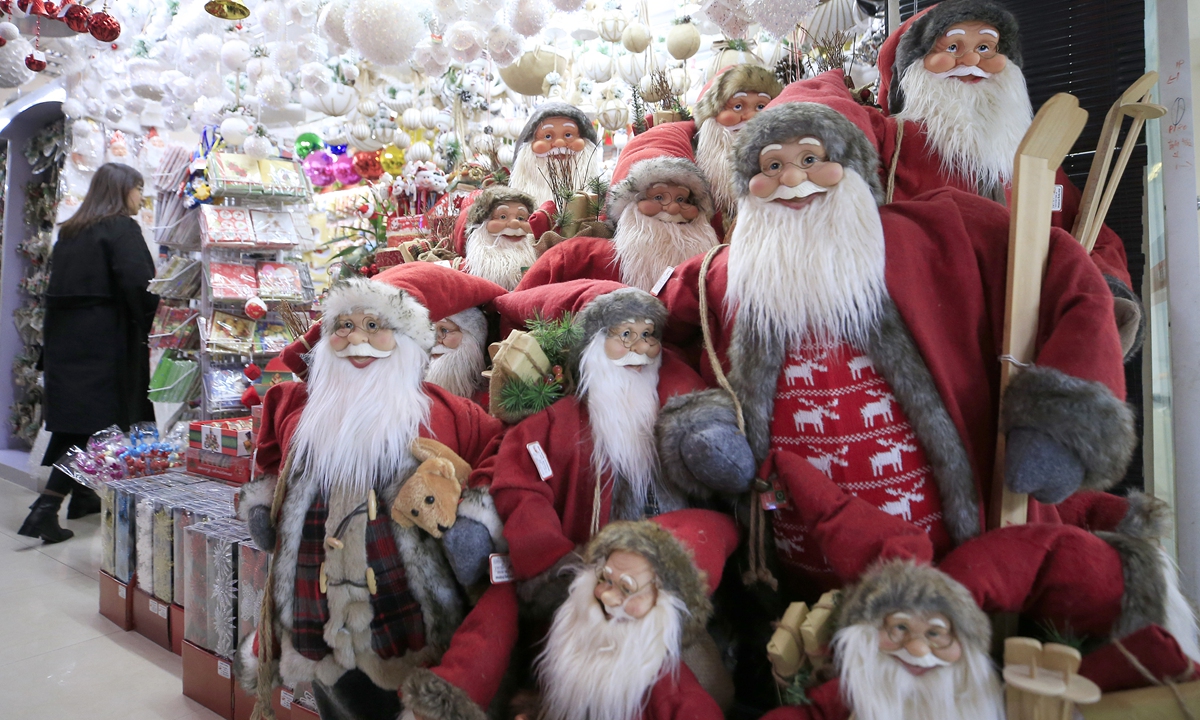
Christmas items on display at Yiwu International Trade City, East China's Zhejiang Province on Friday. Although the peak delivery time for Christmas items abroad had already passed, local suppliers at the trade city still expect visitors at their booths for Christmas gifts and decor. Photo:Yang Hui/GT
It is still half a year until Christmas, and customs and traders in Yiwu, East China's Zhejiang Province, the world's "supermarket" and factory owners in South China's Guangdong Province, the "world's factory," are moving up their schedule to make and deliver much-needed goods to the US and European countries ahead of the biggest holiday of the year.
However, with ports congestion and containers shortage caused by the pandemic affecting supply chains, clients overseas are placing orders earlier than usual - one to three months ahead of time - to secure deals.
A freight agent in Yiwu surnamed Bao, an international trader for years, is shocked by the massive and early arrival of orders for Christmas goods. These orders normally come in late August, but they already came in early June this year, three months ahead of schedule.
"Orders have piled up until early August, and in order to better serve old clients, we have stopped taking new orders," said Bao.
Orders for Halloween, which falls on October 31, also arrived earlier and in huge volume this year.
A producer of Halloween goods in Yiwu surnamed Dai said that hundreds of thousands of the pumpkin-style lanterns that her company provides were sold in less than two weeks -- an unprecedented amount in such a short time. Dai and her staff are working extra hours on production to meet demand.
Factories in Shenzhen in South China's Guangdong Province have also entered peak time early this year.
An employee of a Shenzhen-based decoration manufacturer told the Global Times on Wednesday that the company has already started production on orders from the US and Europe for Christmas this year.
"Due to intense export traffic, we started production one month ahead of the delivery time on the contract," said the person, noting that China's recovering manufacturing sector has also increased the country's export volume and extended the time needed for shipment.
In the first five months of this year, China's exports reached 8.04 trillion yuan ($1.24 trillion), up 30.1 percent year-on-year and 23.6 percent over the same period in 2019, according to customs statistics. Sea transport usually carries about 95 percent of China's foreign trade shipments.
But while export demand has grown, the international capacity for sea freight has fallen sharply.
Since last year, ports in Europe and the US have been affected by the coronavirus, resulting in the slow return of empty containers. This was intensified by the aftermath of the Suez Canal blockage in March and the recent backlog in Yantian Port. Combined with a strike at some US ports, ships have been delayed, ports are congested and containers remain difficult to obtain.
About 10,000 to 15,000 containers are stranded in California and more than 50,000 empty containers are piled up at Australian ports, media reports said.
The container shortages have devastated sea transport, with freight rates tripling compared with the same period last year, industry insiders said.
Wang Yongfeng, a cargo agent in South China's Guangdong Province, said on Thursday that to many traders, sea transport is no longer the first choice because of exorbitant costs.
When a ship loaded with goods arrives at a port overseas, it often returns empty because of the ongoing pandemic in many parts of the world, which means higher costs are passed on to traders, said Wang. The sea transport hurdles may last for another two to three years.
With sea transport facing rising uncertainty, the China-Europe freight train has become a preferred choice for more traders this year, because of its stable and quick delivery and competitive freight rates, industry insiders said.
"The freight train takes less than half of the time that ships take, while train cargo rates, which used to be double those of ships, are now the same," Zhao Hengchao, a director with the port customs at Yiwu West Train Station, told the Global Times on Thursday, noting that the reliability of railway transport is far better than sea transport.
However, the shift in demand has posed new challenges to freight trains. A ship can carry 10,000 to 20,000 standard containers but a cargo train can only carry 50. As more traders choose the train, Zhao said that customs now works 24/7 on inspections to make sure that the goods can be loaded on time.




